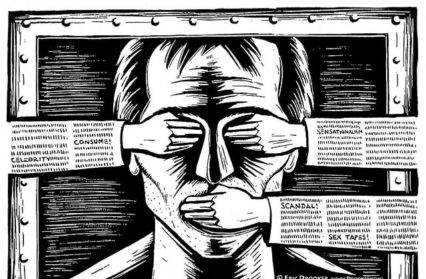Theodore E. Hung takes a contemporary look at the history of censorship in theatre and asks if the modern trend for self-censorship is a healthy one.
The everyday theatre goer in Wales may not know that Wales played a defining role in the abolition of stage censorship in 1968. Topics such as LGBTQ issues; profanity; any depictions of the Royal Family and religious material are only some of the topics that were censored by the Lord Chamberlain and his team of male comptrollers prior to the Act.
The state of censorship goes as far back as the 1700s under the ‘Stage Licensing Act of 1737’. The Act did two things. One, it meant that all new plays or addition to old ones needed to be submitted to the Lord Chamberlain’s office for a theatre license before being performed to the public. Two, the Lord Chamberlain had absolute censoring power over every play that was submitted. Over the years, their power only strengthened with the only censoring guide being their own moral compass. However, the Lord Chamberlain’s old conservative ideals did not survive long in the counterculture era of the 60s. Finally, in 1968 Roy Jenkins, Welsh politician and then Home Secretary of the Labour government was responsible for putting forward the motion to abolish theatre censorship; thus came the ‘Theatres Act of 1968’ – abolishing state censorship in theatre completely.
Many people might think as a result of the Act, theatre censorship is not an issue that needs to be discussed. However, in an age where cultural sensitivity and artistic expression comes head to head constantly, censorship in the theatre becomes a growing concern. In 1968, the ‘Theatres Act’ dissolved the central governing power for theatre censorship. From this, the power of censorship has been given to two types of people – the artists, and the communities artists attempt to represent in their work. The abolishing of censorship in turn created a new era of self-censorship among theatre practitioners. This can be further defined into two types of self-censorship. One, an act of self-censorship carried out by the practitioner themselves due to fear of putting their life at risk by producing content that may seem inflammatory and controversial. Two, an act of self-censorship carried out by the practitioner caused by the intimidation from certain persons, groups and/or communities to change or alter a piece of work. Self-censorship in this context can be defined from cutting a single line to a theatre venue axing a play’s run completely.
In contemporary history, there are three well known productions that were nationally reported to have been affected by self-censorship Behzti (2004) by Gurpreet Kaur Bhatti, was due to be performed at the Birmingham Rep. It was a play that contained a controversial rape scene inside a Sikh temple. This play angered the Sikh community in Birmingham and fiery protests quickly ensued. Consequently, the theatre venue suffered damages to its property and the writer received death threats. Ultimately, the Birmingham Rep decided to cancel the production as it feared for the safety of its staff and customers.
Another example would be Jerry Springer the Opera, written by Richard Thomas and Stuart Lee (2003) it also sparked controversy after the BBC broadcast in 2005 among the Evangelical Christian community. This in turn resulted in multiple theatre venues cancelling performances and the shortening of its UK tour. Lastly, the most recent example would be the National Youth Theatre’s production of Homegrown (2015), written by Omar El-Khairy. A play about the radicalization of Muslims involving young actors between 15 to 25 years of age, which was axed by the NYT during the rehearsal process after receiving several complaints by the parents about the direction of the piece. Even though there are only three examples illustrated here in this article there could be many more plays across the country that are affected by self-censorship which have not been reported by the news.
The Theatre Act of 1968 is vague, much like its predecessors. The Act does not set out guidelines of what is allowed and not allowed. Instead, it created an atmosphere where any practitioner has the right to create anything. However, it is no doubt that the Theatre Act also created an atmosphere where certain topics that were once classed as taboo can now be brought to light to British audiences.
The Theatre Act has done no less for Welsh Theatre either. In the past decade there seems to be a large increase in new outspoken and controversial plays. These include Deepcut first premiering at Sherman Cymru in 2008, about the deaths of four soldiers at Deepcut Barracks; Enough is Enough (2017), a gig/theatre performance about sexual violence; The Assassination of Katie Hopkins(2018), a new musical about the age of sensitivity; and The Wolf Tattoo (2018) a play on the dangers of gang violence towards the vulnerable in the UK. The list goes on.
As we celebrate 50 years of free theatre in a world where cultural sensitivity and artistic freedom of expression comes head to head constantly, let us not forget the power of censorship should be within the parameters of the law and not through intimidation or threats. Theatre should be diverse, and it should celebrate new voices; new stories and not punish those with an opinion. Increased diversity and representation in theatre means that we are raising awareness and sparking new conversations. However, we live in a world where the line between cultural sensitivity and freedom of artistic expression is very fine. Who is right? Who is wrong? Who should budge first? Theatre censorship although abolished on paper – is still very much alive today.











